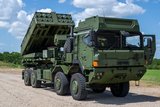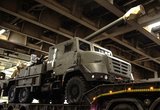Northrop Grumman highlights accomplishments on contractor-operated C-RAM task order
Northrop Grumman Corporation has trained, certified and deployed more than 120 civilian contractors to operate and support the Counter-Rocket, Artillery and Mortar (C-RAM) sense-and-warn system at forward operating bases (FOBs) in Afghanistan.
The first few FOBs with complete sets of contractor-operated C-RAM equipment are now fully operational to protect warfighters serving in Operation Enduring Freedom (OEF).
Several more FOBs nearing completion will soon have a full complement of operators. The OEF FOBs with Northrop Grumman C-RAM sense-and-warn operators are reporting noticeable improvements in capability and responsiveness.
Northrop Grumman's significant progress to provide personnel includes training, certifying and readying for deployment more than 20 operators within 30 days after receiving the task order, which was issued in July under the Defense Information Systems Agency Encore II omnibus contract.
"This is the initial increment of many FOBs scheduled to receive the enhancement of contractor-operated sense-and-warn capability," said Mike Twyman, vice president of integrated command, control communications and intelligence systems for Northrop Grumman's Information Systems sector. "C-RAM is continuing to save lives and improve in-theater operations for our military forces."
Since initial fielding more than five years ago, the C-RAM system is credited with saving hundreds of lives through its ability to provide early warning of incoming indirect fire. Working closely with the US Army, Northrop Grumman helped to take the C-RAM capability from concept to reality in less than 18 months.
"The tremendous accomplishments we've made on C-RAM are only possible through our partnership with the Army C-RAM product manager," said Pat Camacho, director of Critical Infrastructure and Force Protection for Northrop Grumman. "Our deployed team's quality of individuals and their superb performance to date exhibit the best of the best to serve our soldiers in harm's way."
C-RAM uses sensor, command and control (C2) and visualization tools to detect threatening objects and locate the sources of incoming fire. Once the threat is confirmed, its C2 system provides accurate warning to exposed soldiers. Simultaneously, the C2 system provides correlated track data to the intercept system to negate the incoming RAM threat. Additionally, the C2 system passes point of origin and point of impact information on to other systems and sensors to aid the proper response.
Source: Northrop Grumman
More from Land Warfare
-
![Lithuanian 1st Division to achieve initial operating capability in 2026]()
Lithuanian 1st Division to achieve initial operating capability in 2026
Lithuania is one of the countries stepping up its defences in the face of the war in Ukraine with a particular focus on its neighbour and Russian ally Belarus, which has been making incursions into Lithuania’s airspace with balloons and drones.
-
Medium knocked out of British Army LMP, with CAVS as heavyweight champion
As the British Army seeks to modernise and consolidate its diverse vehicle fleet, yet another change in direction is underway.
-
![Energy evolution: How laser defence systems are powering the next phase of air defence (podcast)]()
Energy evolution: How laser defence systems are powering the next phase of air defence (podcast)
Laser-based air defence is moving from promise to deployment as global threats evolve. In this special podcast, we explore how high-energy laser systems are reshaping interception strategies.
























